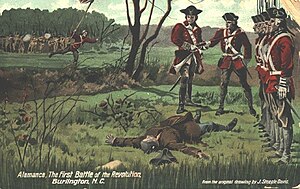Battle of Alamance
| Battle of Alamance | |||||||
|---|---|---|---|---|---|---|---|
| Part of the War of the Regulation | |||||||
 "Alamance, The First Battle of the Revolution, Burlington, N.C., From the original drawing by J. Steeple Davis", written on a postcard, circa 1905-1915 |
|||||||
|
|||||||
| Belligerents | |||||||
| North Carolina Provincial Militia | North Carolina Regulators | ||||||
| Commanders and leaders | |||||||
| Royal Governor William Tryon | Herman Husband, Captain Montgomery, others | ||||||
| Strength | |||||||
| appx. 1,000 | appx. 2,000 | ||||||
| Casualties and losses | |||||||
| Between 9 and 27 killed 61 wounded |
9 killed Unknown number injured 7 later executed for treason |
||||||
The Battle of Alamance was the final battle of the War of the Regulation, a rebellion in colonial North Carolina over issues of taxation and local control. Some historians in the late nineteenth-early twentieth centuries considered the battle to be the opening salvo of the American Revolution, and locals agreed with this assessment. Yet, this has been questioned by present-day historians arguing that the Regulators (though viewed in the eyes of the royal governor and his allies as being in rebellion against King, country, and law) were not intending a complete overthrow of His Majesty's Government in North Carolina. They were only standing up against those certain local officials who had become corrupt and unworthy tools of the King, and they only turned to riot and armed rebellion as a last resort when all other peaceful means through petitions, elections to the Assembly, etc. had failed to redress their grievances. Many surviving ex-Regulators became loyalists during the Revolution, and several anti-Regulators [e.g. William Hooper, Alexander Martin, and Francis Nash] became patriots during the Revolution. Named for nearby Great Alamance Creek, the battle took place in what was then Orange County and has since become Alamance County in the central Piedmont about six miles south of present-day Burlington, North Carolina.
In the spring of 1771, Royal Governor William Tryon left New Bern, mustering and marching approximately 1,000 militia troops west to address a rebellion that had been brewing in western counties for several years, but which had included only minor, scattered acts of violence, followed by refusals to pay fees, disruptions of court proceedings, and continued harassment of government officials. About 2,000 so-called "regulators" had gathered, hoping to gain concessions from the Governor by intimidating him with a show of superior force. Funded by council member and wealthy merchant Samuel Cornell for £6,000, on May 11, Tryon left the county seat of Hillsborough with his militia to confront the Regulators, who had made camp south of Great Alamance Creek in western Orange County (present-day Alamance County).
...
Wikipedia
